Ecology and Physical Setting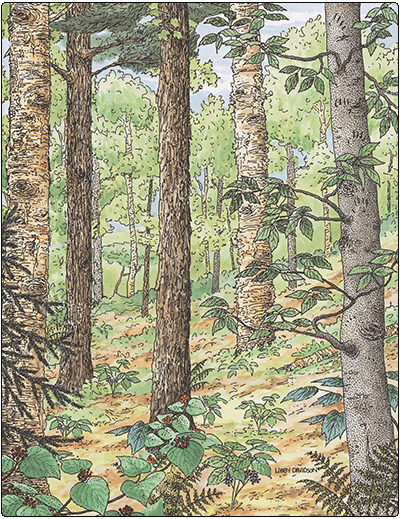
This is Vermont’s most abundant forest, the forest that truly characterizes the Northern Hardwood Forest Formation. It blankets hills in every biophysical region of the state and creates a background setting, a so-called matrix, for the smaller communities—the swamps, fens, outcrops, and meadows. It is a broadly defined community type, encompassing a great deal of variation. But there are some things that all expressions of this community share in common. Beech and yellow birch are almost always present. Sugar maple is usually present, but in some cases red maple is more prominent. Most soils are derived from till and are loamy, cool, and moist. These forests are found at elevations below 2,700 feet on gentle to steep slopes.
Northern Hardwood Forests are generally absent from warmer climate areas, such as the Champlain Valley and the lower elevations of extreme southeastern and southwestern Vermont. They are also absent from other places where soils support specialized communities. Such places include clayplains, alluvial soils along streams and rivers, glaciofluvial deposits of sand or gravel terraces, rocky or bedrock-controlled soils, and wet soils in depressions.
The variations within this community type stem from differences in climate, slope, landscape position, chemistry of the underlying bedrock and till, stoniness, depth to hardpan or bedrock, and past land use. Upper-elevation Northern Hardwood Forests have lower overall species diversity, smaller trees, and sometimes dense fern patches. Forests on convex slopes tend to have more beech and red maple, whereas concave slopes yield more sugar maple and white ash. Yellow birch is dominant where stony soils and natural disturbance provide the right conditions for that species to germinate and grow. White pine occurs in areas of shallow or sandy soils. These variations are often small in scale; for example, a beech-dominated knob may only be a few hundred square feet within a forest otherwise dominated by sugar maple. A large area, then, may be mapped as Northern Hardwood Forest, with the recognition that there is variability within it. Foresters may find it useful to map the variants as stands, so that each can be managed appropriately.
Natural disturbances in Northern Hardwood Forests include death of individual trees, which can create small canopy gaps; wind, which can cause small or large gaps depending on the nature and intensity of the storm; ice loading, which can thin the canopy enough to significantly increase light to the forest floor; snow loading, which can have the same effect, especially when snow falls while leaves are on the trees; downslope movement of soil; and native insects and disease including forest tent caterpillar, saddle prominent, and ash yellows.
Vegetation
Beech, yellow birch, and sugar maple are dominant in the canopy of late-successional Northern Hardwood Forests. Sometimes red maple replaces sugar maple. Hemlock, red spruce, white ash, red oak, butternut, basswood, hophornbeam, and other species can be present as well. Shrubs can be abundant, with striped maple, hobblebush, and shadbush among the common species. The herb layer is usually neither lush nor sparse, but there are local variations. Herbs are long-lived perennials and many of them flower and fruit early in the year, before the forest canopy leafs out. Spring displays of trout lily, spring beauty, and red trillium add impressive spots of color to the forest floor.
Wildlife Habitat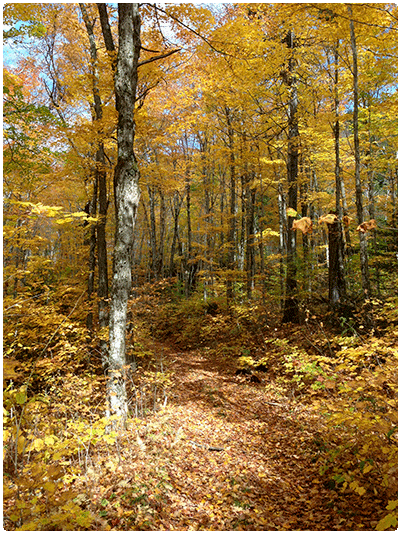
Northern Hardwood Forests provide large expanses of intact forest for many animal species that are sensitive to human disturbance, including birds that nest in the forest interior and some wide-ranging mammals. The interior of large, unfragmented forests provides breeding habitat for black-throated blue warblers, scarlet tanagers, and northern goshawks. Black bears are most secure in forest interiors, although they range into many different habitats.
The variability in Northern Hardwood Forests adds to their habitat values. Concentrations of beech found on drier sites provide abundant energy-rich nuts for bears, turkeys, and blue jays. Young forests resulting from natural disturbance or logging may regenerate to aspens and cherries—these forests are especially important for ruffed grouse. Young forests are also very important for American woodcock, chestnut-sided warbler, and bobcat. Old forests with complex structure, large trees, and abundant coarse woody material support barred owls, scarlet tanagers, and northern long-eared bats. Other common species of Northern Hardwood Forests include northern flying squirrel, eastern chipmunk, hermit thrush, red-eyed vireo, and ovenbird.
Amphibians can be abundant in Northern Hardwood Forests. The eastern red-backed salamander is terrestrial, spending its entire life in moist leaf litter and in rotting stumps and logs. Spotted salamanders and wood frogs are just two of the species that breed primarily in Vernal Pools but spend most of their lives in the leaf litter and under logs of the adjacent forest floor.
Two spring wildflowers found primarily in Northern Hardwood Forests are the sources of pollen for two bee species. Spring beauty andrena and trout-lily andrena have very specific associations with their namesake flowers.
Successional Trends
Since this is such a variable community type, its early-successional stages are variable, too. Post-agricultural succession often leads to pure stands of white pine, which are eventually replaced by hardwoods. Thus, stands that are pine dominated today may actually be Northern Hardwood Forests. Soils are a good indicator of whether pine will persist or not. Coarse soils are more likely to support pine over long periods of time.
White pine is not the only post-agricultural successional species, however. Others are gray birch (on shallower soils), bigtooth aspen, quaking aspen, black cherry, pin cherry, and in the north, white spruce, red spruce, balsam fir, and northern white cedar. Some of these species can persist for a long time, and remain a component of mature forests, while others are short-lived. The tree species that become established in an old field depend on the soils, the nature of the agricultural disturbance (pasturing vs. cropland), the duration and intensity of the disturbance, and the local seed sources.
Where logging is the major disturbance to a Northern Hardwood Forest, the most common early-successional trees are yellow birch, white ash, bigtooth aspen, quaking aspen, sugar maple, pin cherry, paper birch, and white pine. Pin cherry and paper birch are especially prevalent in large openings left by logging.
Large-scale natural disturbances can have a similar effect on the canopy. For example, the species that come in after logging will also come in after a large disturbance such as a blowdown caused by a hurricane. In the case of the more common small-scale disturbances, such as the death or blowdown of individual trees, yellow birch, white ash, and sugar maple tend to come into openings.
Invasive non-native species can affect the successional pathway, too. Dense populations of invasive shrubs such as Morrow’s honeysuckle can slow the return of native trees to an area. Even when native trees become re-established, honeysuckle can persist in the understory for a long time, replacing native shrubs and herbs. The warming climate is allowing many invasive species to expand their ranges in Vermont.
Beech has its own story. In addition to producing seeds, it reproduces vegetatively, sending up root suckers, or new sprouts, from older trees. A beech that has been cut still has the potential, for at least the first year, to produce a thicket of young new sprouts. Where beech does well (on drier microsites within Northern Hardwood Forests), it can, following logging, remain the dominant species or become more abundant because of this strategy. Further complicating the story, beech-bark disease compromises adult trees and promotes sprouting.
Variants
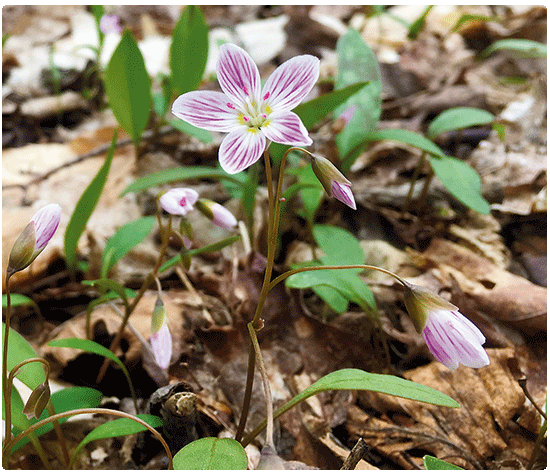
- Beech-Red Maple-Hemlock Forest differs from the core Northern Hardwood Forest in that in mid-successional stands beech and red maple are the most common canopy components. Yellow birch and black birch can be present, depending on climate (black birch is restricted to the warmer areas of the state). This variant occurs on convex knobs, where soils are relatively dry. Soils may be coarser than in other Northern Hardwood Forests. These sites can be shallow to bedrock, or moderately deep to hardpan. They are on gentle to moderate slopes. Late-successional examples of this variant may be dominated by beech and hemlock, whereas red maple (a shade-intolerant tree) will decline as a stand matures. Common herbs in Beech-Red Maple-Hemlock Forests are starflower, Canada mayflower, shining clubmoss, beech drops, and Indian pipes.
- Sugar Maple-White Ash-Jack-in-the-Pulpit Forest shows slight enrichment from either nutrient accumulation or enriched bedrock or till. Sometimes it is found in concavities in the slope, where nutrients accumulate. Or as is common in the Southern Vermont Piedmont, it occurs on ridgetops. Mid-successional trees are white ash, sugar maple, black cherry, and yellow birch, with occasional butternut, hophornbeam, basswood, and red oak. Minor components are red maple, hemlock, and red spruce. Late-successional trees are sugar maple and white ash. Characteristic herbs are Jack-in-the-pulpit, white baneberry, red trillium, Christmas fern, blue cohosh, early yellow violet, lady fern, and wild oats.
- Yellow Birch-Northern Hardwood Forest occurs where yellow birch is stable as a canopy dominant. In general, yellow birch is considered an early to mid-successional tree, capable of persisting long term only when occasional local disturbances create the mineral soil seedbed or supply the nurse logs that this species needs to germinate. But where rocks and boulders are common at the surface, there may be a perpetual source of good sites for yellow birch seeds to germinate, and the species may therefore persist in these places for a long time as a dominant in the canopy.
- White Pine-Northern Hardwood Forest: White pine in Northern Hardwood Forests is often a result of past disturbance, at least in Vermont. It can be a natural component of Northern Hardwood Forests, however, where soils are coarser and more well drained. This variant describes those areas where white pine is a significant canopy component, but not because of past human use. Wherever white pine is common, it should be evaluated to determine whether it is likely to persist over time by looking at soils and the regeneration of pine in the understory.
Related Communities
- Rich Northern Hardwood Forest is most like Sugar Maple-White Ash-Jack-in-the-Pulpit Forest (see “Variants”), but it is more enriched, with greater overall diversity, better productivity, and more biomass in forest floor herbs. It is usually associated with enriched bedrock or till, or colluvial slopes.
- Hemlock-Northern Hardwood Forest is most like the Beech-Red Maple-Hemlock Forest variant in that soils are shallow and well drained. Hemlock is co-dominant in the canopy.
- Red Oak-Northern Hardwood Forest is found on slightly warmer sites and has a significant and persistent component of red oak in addition to northern hardwood species. Maple-leaved viburnum is a distinctive shrub in this community.
- Northern Hardwood Talus Woodland occurs on rockfall and has yellow birch, paper birch, and white ash as common canopy species, with mountain maple and red-berried elder as common shrubs.
- Mesic Maple-Ash-Hickory-Oak Forest occurs in warmer climate areas where hickories and oaks are common in the forest canopy, along with sugar maple, basswood, and white ash. Its ground vegetation also shows its southern affinities. This community is often mildly enriched either because of bedrock influence or colluvial processes.
Conservation Status and Management Considerations
There are very few Northern Hardwood Forests that have not been logged or cleared at some time. Even those few areas that were spared clearing or logging were probably used for maple sugar production. But the encouraging conservation story is that Northern Hardwood Forests have recovered amazingly well from the 19th century clearing of the land. Natural ecological processes are once again predominant, and in most places native species once again prevail. Today, much of the forest is still used for timber harvesting and sugaring, but these can be minor disturbances if carefully planned and executed. Threats to Northern Hardwood Forests include fragmentation from road building and rural development, as well as permanent clearing for agriculture or industrial and urban development. Human activities have brought non-native pathogens such as beech bark disease, gypsy moth, and hemlock woolly adelgid. Emerald ash borer is a new and emerging threat.
While most of these forests will continue to be managed for timber and other products, it is critically important that we also conserve unmanaged Northern Hardwood Forests. The complex structure of unmanaged old forests creates diverse habitats—many of which are not present in younger forests—and makes them remarkably resilient.
There are, however, many human activities that are compatible with conservation in Northern Hardwood Forests. Carefully managed Northern Hardwood Forests can protect biological diversity and ecological functions. Managers of Northern Hardwood Forests should first understand what they have by inventorying and mapping natural communities and variants. Management should encourage the species that naturally occur in an area, in their natural proportions. For example, if white pine is present because of former agricultural practices, it does not make sense to artificially maintain it. Red oak should only be encouraged if the soils and seed sources suggest that it would persist over time naturally. On dry knobs, beech, red maple, and hemlock are the species that should be favored, whereas it might be advantageous to reduce beech in a moist cove where sugar maple will do well.
Distribution/Abundance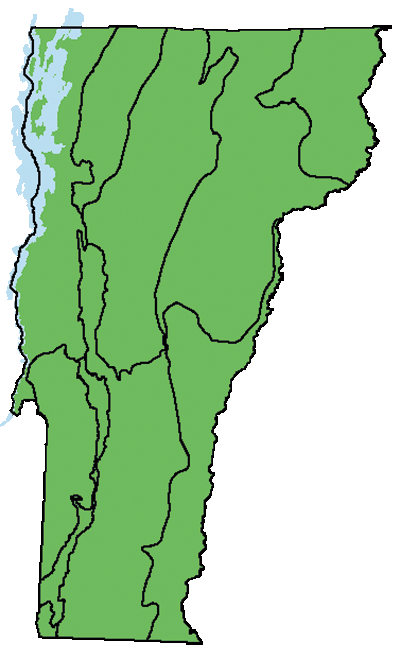
Northern Hardwood Forests are found throughout the state at elevations below 2,700 feet, although the upper elevation limit is lower in the north.
Characteristic Plants
Trees
Abundant Species
Sugar maple – Acer saccharum
Yellow birch – Betula alleghaniensis
American beech – Fagus grandifolia
Occasional to Locally Abundant Species
Eastern hemlock – Tsuga canadensis
Red maple – Acer rubrum
White ash – Fraxinus americana
White pine – Pinus strobus
Black cherry – Prunus serotina
Black birch – Betula lenta
Basswood – Tilia americana
Red spruce – Picea rubens
Shrubs
Abundant Species
Hobblebush – Viburnum lantanoides
Striped maple – Acer pensylvanicum
Shadbush – Amelanchier spp.
Occasional to Locally Abundant Species
Canada honeysuckle – Lonicera canadensis
Beaked hazelnut – Corylus cornuta
Alternate-leaved dogwood – Cornus alternifolia
Herbs
Abundant Species
Intermediate wood fern – Dryopteris intermedia
Christmas fern – Polystichum acrostichoides
Shining clubmoss – Huperzia lucidula
Sarsaparilla – Aralia nudicaulis
Occasional to Locally Abundant Species
Painted trillium – Trillium undulatum
Whorled aster – Oclemena acuminata
Wild oats – Uvularia sessilifolia
Lady fern – Athyrium filix-femina
Canada mayflower – Maianthemum canadense
Red trillium – Trillium erectum
Spring beauty – Claytonia caroliniana
Trout lily – Erythronium americanum
False Solomon’s seal – Maianthemum racemosum
Rose twisted stalk – Streptopus lanceolatus
Starflower – Lysimachia borealis
Indian cucumber root – Medeola virginiana
Indian pipes – Monotropa uniflora
Beech drops – Epifagus virginiana
Early yellow violet – Viola rotundifolia
Jack-in-the-pulpit – Arisaema triphyllum
Long beech fern – Phegopteris connectilis
Zigzag goldenrod – Solidago flexicaulis
Common wood sorrel – Oxalis montana
Hay-scented fern – Dennstaedtia punctilobula
Invasive Non-native Plants
Morrow’s honeysuckle – Lonicera morrowii
Tatarian honeysuckle – Lonicera tatarica
Japanese barberry – Berberis thunbergii
Common buckthorn – Rhamnus cathartica
Rare and Uncommon Plants
Broad beech fern – Phegopteris hexagonoptera
Male fern – Dryopteris filix-mas
Three-birds orchid – Triphora trianthophora
Large roundleaf orchis – Platanthera macrophylla
Associated Animals
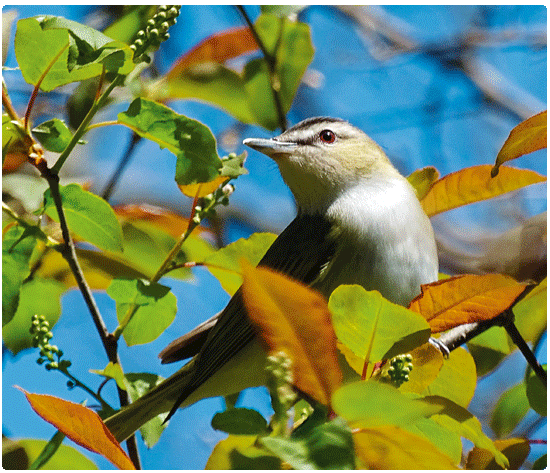
Spotted salamander – Ambystoma maculatum
Wood frog – Lithobates sylvaticus
Eastern red-backed salamander – Plethodon cinereus
Eastern newt – Notophthalmus viridescens
Smoky shrew – Sorex fumeus
Southern flying squirrel – Glaucomys volans
Northern flying squirrel – Glaucomys sabrinus
Eastern chipmunk – Tamias striatus
Porcupine – Erethizon dorsatum
Black bear – Ursus americanus
Bobcat – Lynx rufus
Gray fox – Urocyon cinereoargenteus
Fisher – Pekania pennanti
Hermit thrush – Catharus guttatus
Rose-breasted grosbeak – Pheucticus ludovicianus
Ovenbird – Seiurus aurocapilla
Red-eyed vireo – Vireo olivaceus
Black-and-white warbler – Mniotilta varia
Black-throated blue warbler – Setophaga caerulescens
Scarlet tanager – Piranga olivacea
Ruffed grouse – Bonasa umbellus
Hairy woodpecker – Picoides villosus
Pileated woodpecker – Dryocopus pileatus
American woodcock – Scolopax minor
Broad-winged hawk – Buteo platypterus
Barred owl – Strix varia
Spring beauty andrena – Andrena erigeniae
Trout-lily andrena – Andrena erythronii
Rare and Uncommon Animals
Northern long-eared bat – Myotis septentrionalis
Northern goshawk – Accipiter gentilis
Places to Visit
Camel’s Hump State Forest, Huntington and Duxbury, Vermont Department of Forests, Parks, and Recreation (VDFPR)
Mount Mansfield State Forest, Stowe and Underhill, VDFPR
Coolidge State Forest, Plymouth, VDFPR
Lord’s Hill Natural Area, Groton State Forest, Groton, VDFPR
